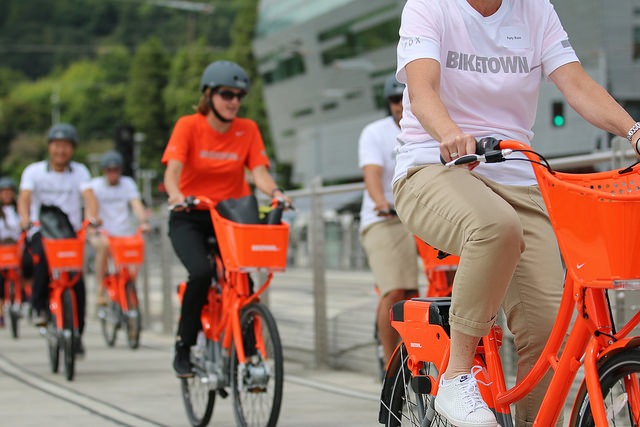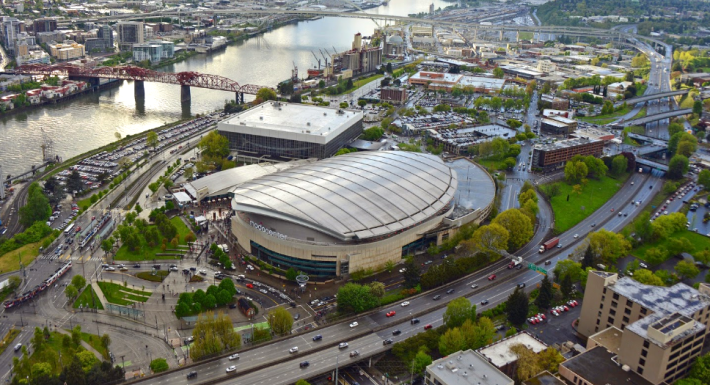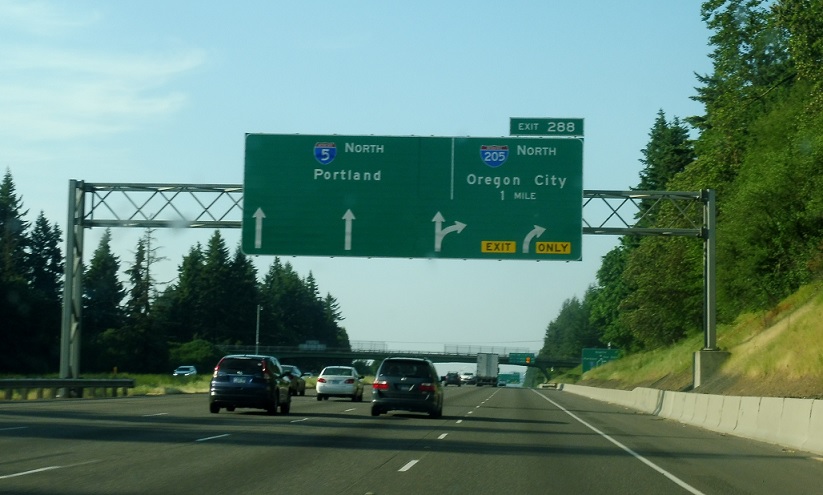In this year's installment of its annual “Highway Boondoggles” report, Gideon Weissman of Frontier Group and Matthew Casale of U.S. PIRG Education Fund deliver a stark warning about the billions of dollars states spend on unnecessary highways that fracture our cities, deprive transit of scarce funds, and pollute our environment. Below is the eighth of nine installments detailing case studies of these harmful roadways: Portland's I-5 Rose Quarter widening, an expensive highway project would constitute a step backward to the car-dependent policies of the past.
Portland has made bold moves toward becoming a good place to get around without a car. New funding will soon create further bus-rapid-transit routes. The Oregon city has a widely used bike-share program. The city has plans to remove parking spaces and use the space for new bus, streetcar, and bike lanes. Portland has also set a goal of 25 percent of trips to be made by bicycle by 2030, and from 2000 to 2015 the share of people who commute by bike increased from less than 2 percent to 7 percent.

But even as Portland shifts toward a safer and more sustainable transportation system, the state is planning a $450 million project to widen and add lanes to I-5 through Portland’s Rose Quarter. The project would raise the number of lane-miles of freeway in the project area by 50 percent, with extra-wide shoulders that could fit an even higher-capacity freeway in the future. If built, the project will mean more driving, more pollution, and a step backward for the city.
According to the state, the project is needed because of poor safety, high congestion and poor street-level service for bicyclists and pedestrians. But there is little evidence that the first two needs will be served well by the project. The local advocates and official city advisers who have long pushed for better streets argue that street-level plans are inadequate and outweighed by the adverse effects of a bigger highway.
Project documents claim that I-5 in the Rose Quarter “experiences some of the highest vehicle crash rates in Oregon.” Yet, according to Oregon Metro, a regional government agency, the state has not proved that the section of road in questions is unsafe, and has not provided “information on how the project area compares for serious crashes.”
Indeed, other ODOT highways in Portland have higher crash rates. Metro also notes that the state has not explained how the project “will reduce the number and severity of serious crashes occurring.” The state’s crash analysis cites driver behavior as a primary factor in all crashes, but as Metro writes, it is “not clear how the design solutions in the Build Alternative will address behavior.”

When it comes to the goal of improving traffic flow and freight traffic, the strategy for expanding I-5 through the Rose Quarter is to fix what has been termed a “bottleneck.” But according to local think tank City Observatory, Portland’s own history of fixing an I-5 traffic bottleneck exemplifies why the strategy is likely to fail. After a nearby 2010 project to widen I-5 between Lombard Street and Victory Boulevard, the widened highway simply delivered “more traffic, faster, to the next bottleneck in the system.”
As a result of changes to traffic flow, congestion (along with the crash rate) actually rose. A better solution for reducing congestion along I-5 could be congestion pricing, which an ODOT study concluded could lead to “major improvements in travel times.” Despite ODOT’s own finding, the agency does not appear to have seriously considered pricing as an alternative to the widening project.
On the streets around I-5 in the Rose Quarter, improvements for walking and biking are badly needed. But proposed plans for city streets have been criticized for being inadequate improvements for those on bike or foot. Portland’s official walking and biking advisory committees both oppose the project.
Portland’s Bicycle Advisory Committee wrote that “the Build Alternative would fail to achieve the stated project goals and objectives, especially in critical areas related to bicycling, but also including the resulting conditions for walking and transit. . .”
City Observatory noted that the “freeway widening project creates a bike- and pedestrian-hostile environment” in which wider turning radiuses would encourage faster vehicle speeds through crosswalks.
Metro observed that the “width of Broadway between Williams and 1st is shown as five (5) one-way motor vehicle lanes, which is incompatible with a multimodal, mixed-use environment, and may increase poor driver behavior.”
Local groups like Bike Portland have challenged the street-level alterations included in the I-5 project, which make up just a small fraction of total costs, as being used by the Oregon DOT for “green-washing, bike-washing, and safety-washing yet another massive investment in automobile-oriented infrastructure.”
An expanded highway will also likely cause more carbon emissions, hindering Portland’s ability to achieve its emission reduction goals. ODOT’s own environmental assessment actually projects that the project will result in slightly reduced emissions compared to a “no build” option.
Yet an analysis by City Observatory found the opposite, estimating the project will raise annual greenhouse-gas emissions by 4,700 to 7,900 tons as a result of more driving. Local researchers have noted they are unable to assess the validity of ODOT’s findings, because the state has not made underlying traffic data available.
Portland has set a goal of reducing carbon emissions by 80 percent from 1990 levels by 2050, and a corresponding objective of reducing per-capita vehicle miles traveled by 30 percent by 2030. The proposed I-5 expansion would make it harder to achieve both goals.
Even as the Oregon Department of Transportation seems to be overstating the ability of expanding I-5 to achieve its transportation goals, the agency seems to be understating its environmental impacts. At a public hearing, critics of the project presented evidence that ODOT failed to fully account for increases in traffic and pollution that would result from the project.
Sponsored post: Spin and Better Block Foundation are calling on designers, urbanists and anyone who cares about safe and livable streets, to submit ideas for a new generation of multimodal parklets. Winning designs will get built and installed in Denver in September. Let’s take back our streets from cars, one space at a time. Apply now: https://www.spin.pm/streets






